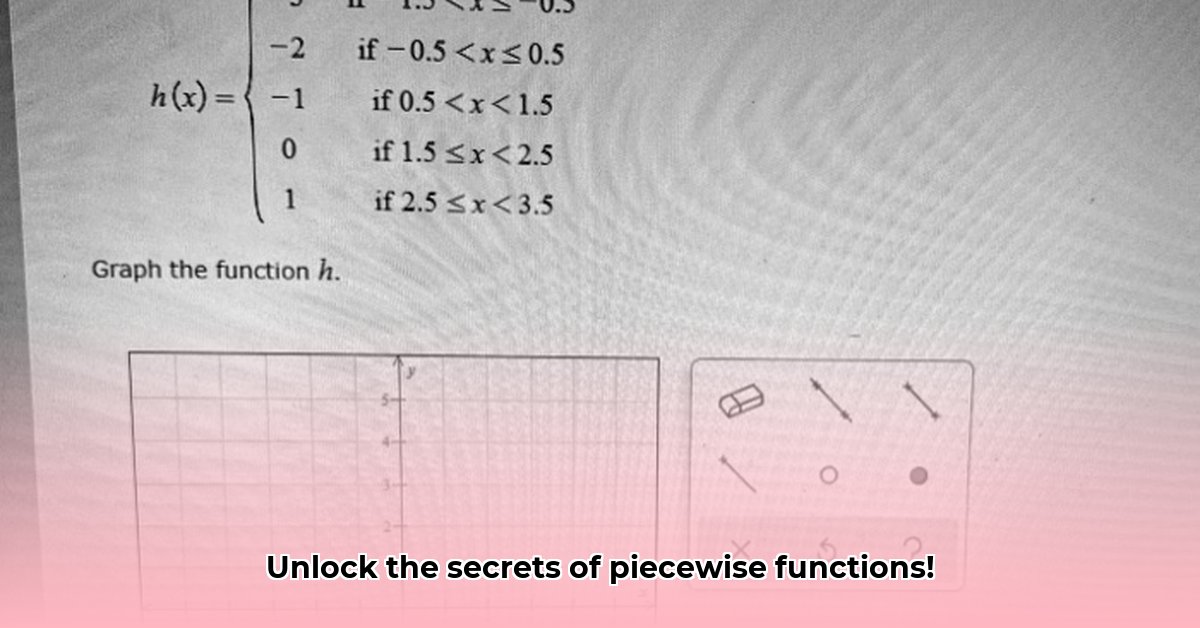
Piecewise functions, despite their intimidating name, are simply functions defined by different rules for different parts of their input values. This guide provides a step-by-step approach to evaluating them, benefiting students, educators, and even software developers. Let's demystify these functions and make them entirely manageable!
Understanding Piecewise Functions
A piecewise function is like a mathematical chameleon, changing its behavior depending on the input. Imagine a function, f(x), defined as:
f(x) = { x² if x < 0
{ 2x + 1 if x ≥ 0
This means if x is negative, we square it, but if x is zero or positive, we use the rule 2x + 1. This adaptability makes them surprisingly useful for modeling real-world scenarios with abrupt changes, like tax brackets or the speed of a vehicle.
Step-by-Step Evaluation
Evaluating a piecewise function involves two key steps:
Step 1: Identify the Governing Rule
The first step is to determine which expression applies to the given x value. Let's evaluate f(-2), f(0), and f(3) from our example:
f(-2): Since -2 < 0, we use the first rule: f(-2) = (-2)² = 4.
f(0): Since 0 ≥ 0, we use the second rule: f(0) = 2(0) + 1 = 1.
f(3): Since 3 ≥ 0, we use the second rule: f(3) = 2(3) + 1 = 7.
Step 2: Perform the Calculation
Once the correct expression is identified, simply substitute the x value and calculate. Remember to use the order of operations (PEMDAS/BODMAS) correctly. This often involves basic arithmetic, but could extend to more complex operations depending on the function definitions.
Common Pitfalls to Avoid
Many students make mistakes due to simple oversight. Here are the most common errors and how to avoid them:
Incorrect Rule Selection: Carefully examine the conditions defining each part of the piecewise function (e.g., x < 0, x ≥ 0). Always double-check that your selected rule corresponds to the given input value.
Calculation Errors: Take your time to avoid mistakes in basic arithmetic or more complex calculations. A small error can make a big difference in the final result. Double check your work!
Misinterpreting Notation: Familiarize yourself with the notation. Understanding how the piecewise function is written is vital before performing the calculations.
Practice Problems
Test your understanding with these exercises:
- Given:
g(x) = { 1/(x+1) if x < 1
{ x² + 1 if x ≥ 1
Find g(-2), g(0), and g(2).
- Given:
h(x) = { |x| - 2 if x ≤ 2
{ 4 if x > 2
Find h(-1), h(2), and h(5).
(Solutions are found at the end.)
Advanced Concepts: Continuity and Limits
For more advanced students, piecewise functions offer opportunities to explore concepts like continuity and limits. A function is continuous if you can graph it without lifting your pen – a smooth, unbroken line. Limits describe the function's behavior as x approaches a specific value. Transition points often require careful analysis to determine continuity and limits. The analysis frequently involves examining one-sided limits (limits from the left and right).
Solutions to Practice Problems
g(-2) = -1, g(0) = 1, g(2) = 5
h(-1) = -1, h(2) = 0, h(5) = 4
Mastering piecewise functions takes practice. The more problems you solve, the more confident you will become in identifying applicable rules and performing calculations. Remember: Careful attention to detail is key!